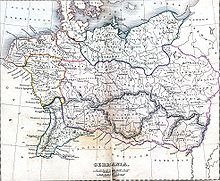Germanic peoples
![]()
This article is about the Germanic tribes in Europe. For the chemical substance, see Germanic (chemistry).
Germanic is the name given to a group of former tribes in Central Europe and southern Scandinavia, whose identity in research is traditionally determined by language. Characteristics of the Germanic languages are, among other things, certain sound changes compared to the reconstructed Indo-Germanic original language, which are summarized as the Germanic or first sound shift. The settlement area inhabited by the Germanic peoples was accordingly called Germania magna by the Romans.
From the turn of the ages, contact with the Romans shaped the Germanic world, just as the development of the Roman Empire increasingly connected with the Germanic world. In late antiquity, in the course of the "migration of peoples", there were far-reaching moves of several Germanic tribes (gentes), some of which formed larger associations (see ethnogenesis), eventually and finally their invasion of the Roman Empire. Their goal was above all to share in the prosperity of the empire, whose structures and culture they by no means wanted to destroy. Some of these groups founded empires on the ancient Roman model on the soil of the Western Empire, which fell around the year 476. Elements of Germanic religion and religious customs were transferred, among other things by accommodation, into the adopted Christianity.
This article describes the general history of the Germanic peoples, beginning before the turn of time, until late antiquity or the beginning of the early Middle Ages. In research, the history of Scandinavia until the Middle Ages is also seen in the Germanic context. The history of individual tribes, Germanic mythology and Germanic tribal rights are the subject of further articles.

Germania magna in the early 2nd century, 19th century map by Alexander George Findlay.
Questions and Answers
Q: What is the Germanic peoples?
A: The Germanic peoples are a linguistic and ethnic branch of Indo-European peoples who came from Northern Europe and are identified by their use of the Germanic languages.
Q: How did they spread throughout Europe?
A: Migrating Germanic peoples spread throughout Europe, mixing with existing local populations (like Celts, Slavs/Vends, and Romans). They eventually formed the basis of many nations.
Q: What does "German" mean in English?
A: In English, "German" is first attested in 1520, replacing earlier use of Almain or Dutch. Today, in English, “Dutch” means the language or people of the Netherlands.
Q: How were the different tribes divided up geographically?
A: The East Germanic tribes lived around the rivers Oder and Vistula in what is now Poland; The Istvaeones lived around the lower Rhine River; The Irminones lived around the Elbe River in what is now Germany; And The Ingvaeones lived in Jutland and other islands that now belong to Denmark.
Q: What were some myths about how each tribe was created?
A: Myths said that Angul created the Angles; Aurvandil created the Vandals (though historians are not certain this actually happened); Burgundus created the Burgundians; Cibidus created the Cibidi; Dan created the Danes; Nór createdthe Norwegians; Gothus createdthe Goths ; Ingvecreatedthe Ynglings ; Irmincreatedthe Irminones ; Longobarduscreatedthe Lombards ; Saxneatcreatedthe Saxons ; Valagothuscreatedthe Valagoths ; Suionescreatedthe Swedes (Svear).
Q: Who claimed power based on these myths?
A: Some Germanic kings claimed that they should have power because they were related to their tribe’s mythical founders.
Search within the encyclopedia